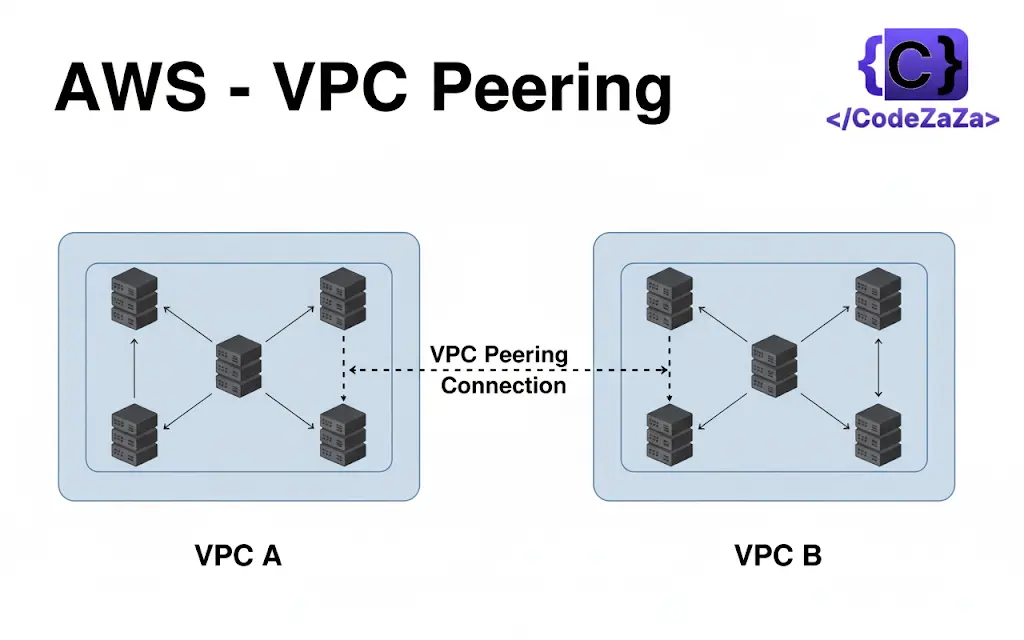Virtual Private Cloud Peering is known as VPC Peering. It is an AWS networking function that provides safe and direct communication between different VPCs. By using the VPC peering feature organizations can establish private connections that facilitate the secure and smooth transfer of resources and data across various VPCs in the AWS Cloud. By establishing communication between different environments and maintaining the integrity of each VPC environment setting, VPC peering makes network management easier.
In the AWS ecosystem, VPC peering is an essential service for creating scalable, networked infrastructure structures. Amazon peering provides an effective way of linking Virtual Private Clouds (VPCs) and offers strong networking capabilities inside AWS. In this Article, the complexities of VPC peering are addressed with an effective way of explanation. This article clarifies how to establish smooth communication across different cloud environments in AWS.
AWS VPC Peering Architecture
AWS VPC Peering lets you connect two Virtual Private Clouds (VPCs) so they can exchange traffic using private IP addresses. This setup enables resources in one VPC to communicate directly with resources in another VPC without relying on an internet gateway, NAT device, VPN, or physical connection. You can create VPC peering connections both within a single AWS account and across different AWS accounts, depending on your requirements.
Architecture Overview
Consider the following VPC peering scenario:
- VPC A (Your Account): Hosts EC2 instances, databases, and other applications. This VPC serves as the requester in the peering setup.
- VPC B (Third-Party Account): Contains services or applications that your VPC needs to access. This VPC acts as the accepter.
- VPC Peering Connection: Establishes a private link between the two VPCs, enabling seamless communication without traversing the public internet.
By implementing VPC peering, you maintain low-latency, high-bandwidth connections between VPCs. Additionally, traffic remains within the AWS network, improving security and reliability. To enable communication, you must update route tables in both VPCs and configure security group rules accordingly

AWS VPC Peering Connection Lifecycle
The lifecycle of an AWS VPC peering connection involves several key stages. Each stage ensures the connection is properly requested, established, configured, and maintained. The stages are discussed in detail below:
1. Initiation
The lifecycle begins when you initiate a request to peer two VPCs. During this step, you specify which VPCs you want to connect and provide their respective settings, such as the CIDR blocks and account information. Proper planning at this stage ensures that the VPCs can communicate without conflicts or overlapping IP ranges.
2. Approval
After raising the request, the administrator of the receiving VPC must approve the peering connection. Both parties confirm the connection settings and agree to establish the peering link. This step ensures that both VPCs are aware of and consent to the communication setup.
3. Establishment
Once both VPCs approve the request, the VPC peering connection is established. At this point, instances in one VPC can communicate with instances in the other VPC using private IP addresses, provided they are in the same network. This stage marks the successful creation of a private communication channel between the two VPCs.
4. Configuration
After establishing the connection, the administrator configures route tables and security groups to control traffic flow between the peered VPCs. This ensures that communication follows the desired network paths and remains secure. Proper configuration allows only the necessary traffic while preventing unauthorized access.
5. Utilization
With the connection configured, resources in the peered VPCs can communicate seamlessly. Organizations can use this setup for a variety of purposes, including:
- Data replication between databases
- Resource sharing such as centralized services or storage
- Application integration across multiple VPCs
This stage maximizes the value of the VPC peering connection.
6. Monitoring and Maintenance
Administrators must continuously monitor the performance and security of the VPC peering connection. They also perform maintenance tasks, such as updating route tables or adjusting security group rules, to optimize performance and ensure reliability. Regular monitoring helps detect issues before they impact applications.
7. Termination (Optional)
If necessary, administrators can terminate the VPC peering connection. Termination disables the network link between the VPCs and stops any further communication. Organizations typically perform this step when a connection is no longer needed or when network architecture changes.
How VPC Peering Works: Multi-VPC Connections
Multiple VPC peering connections are allowed for a network toplogy where multiple Virtual Private Clouds (VPCs) are interconnected. This provides the granular control over the communication between components or environments within an organization’s cloud infrastructure. Each peering operates independent chanels and security configurations between specific VPC pairs. Adminstators can strategically deploy and manage mutiple peering connections to support many use cases such as multi-tiered application architectures, segregated development environments or distributed microservices deployments.

These VPCs can be in different regions and are hence known as inter-region VPC Peering connections.
How to Setup AWS VPC Peering Connections: A Step-By-Step Guide
Step 1: Navigate to VPC Dashbaord
- Sign in to your AWS account with your credentials.
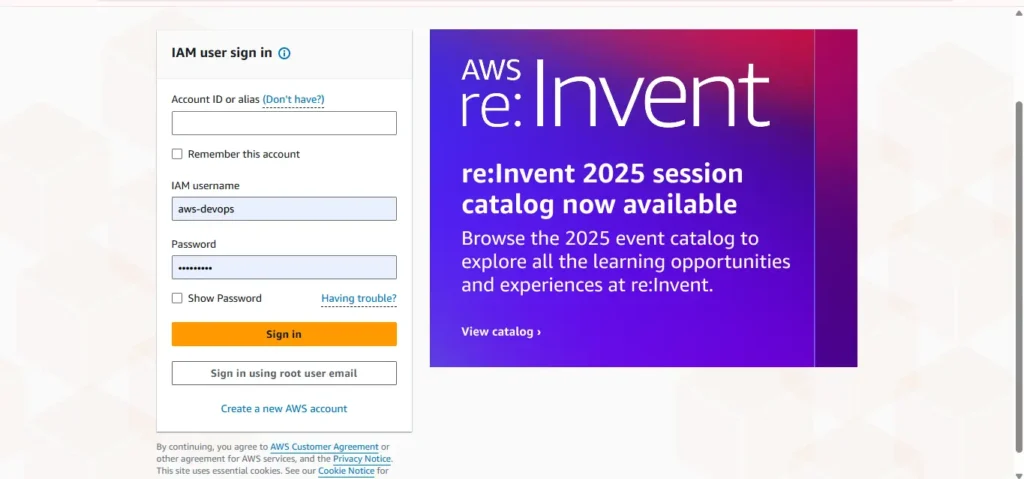
- After Navigate to Console, you look into the following Console Home Page
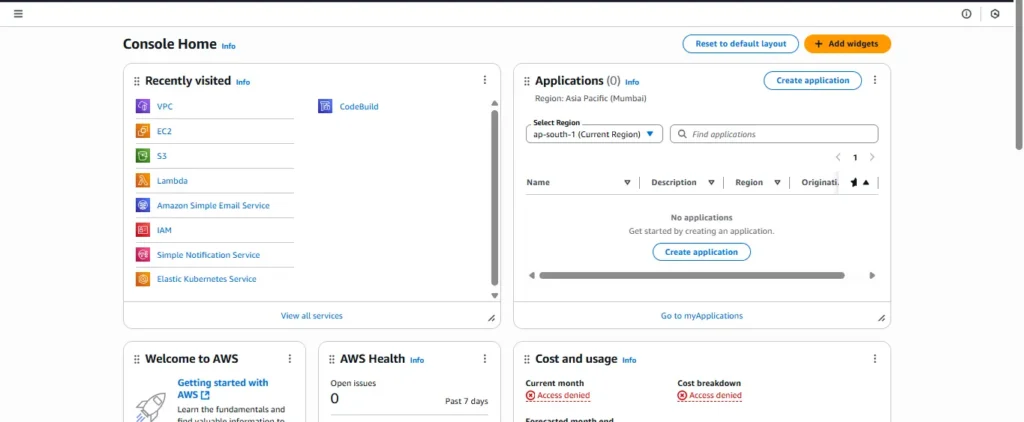
- Select the VPC service in the search box.
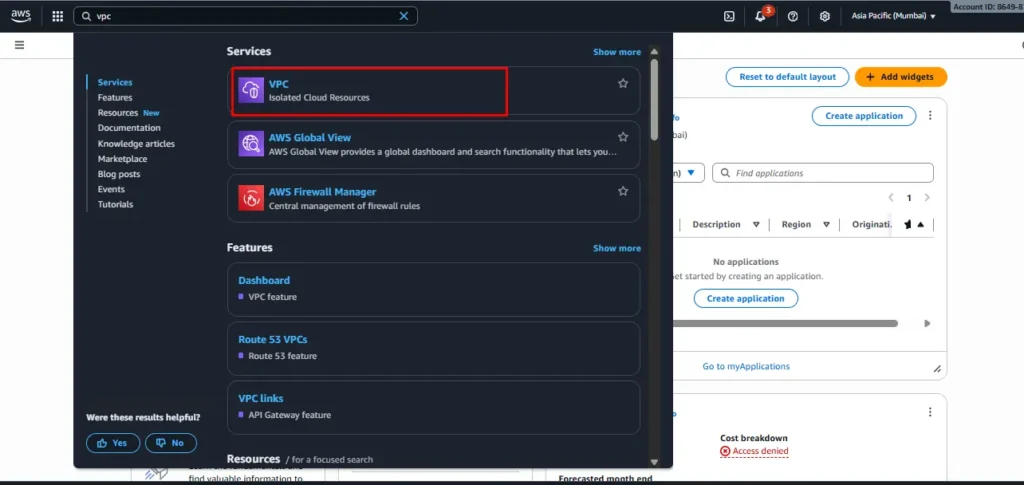
Step 2: Create Virtual Private Network
- Create 2 VPC networks with names test-vpc-1 and test-vpc-2.
- Firstly, Click on the Create VPC button to create VPC.
- Configure the VPC details as shown in the below screenshot.
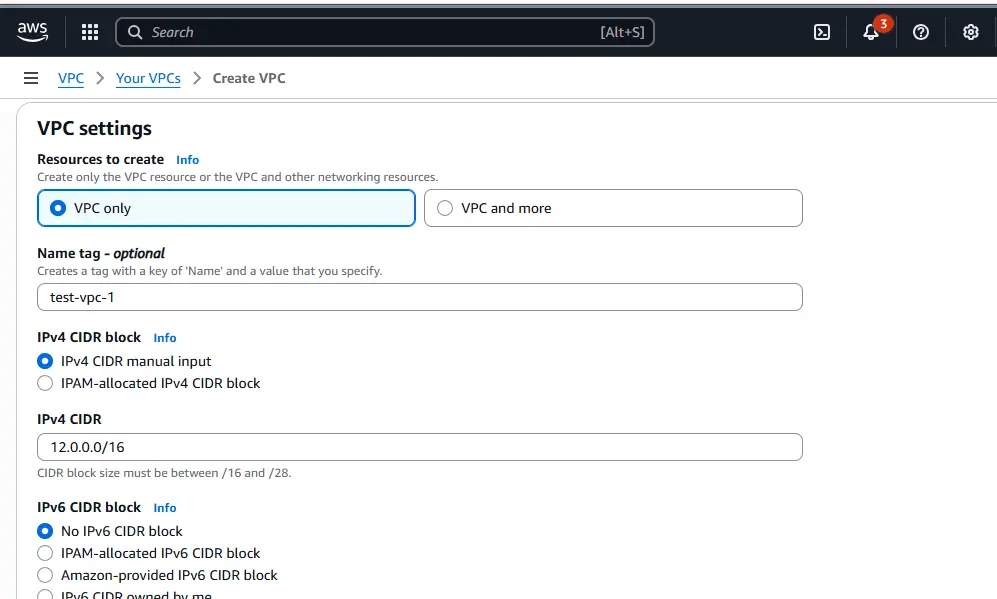
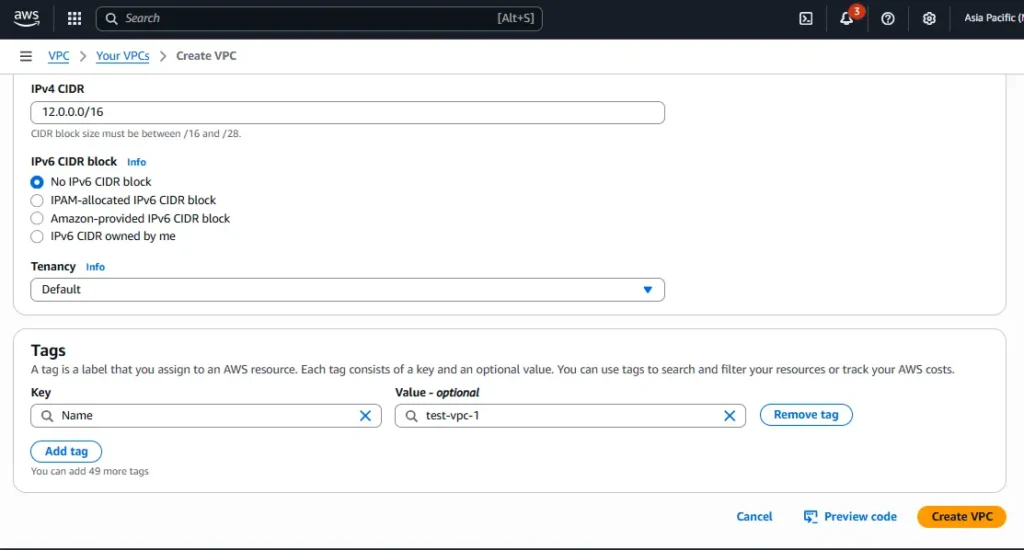
- Similarly define and create second vpc with name test-vpc-2 . Ensure that the CIDR of test-vpc-1 and test-vpc-2 doesn’t overlay.
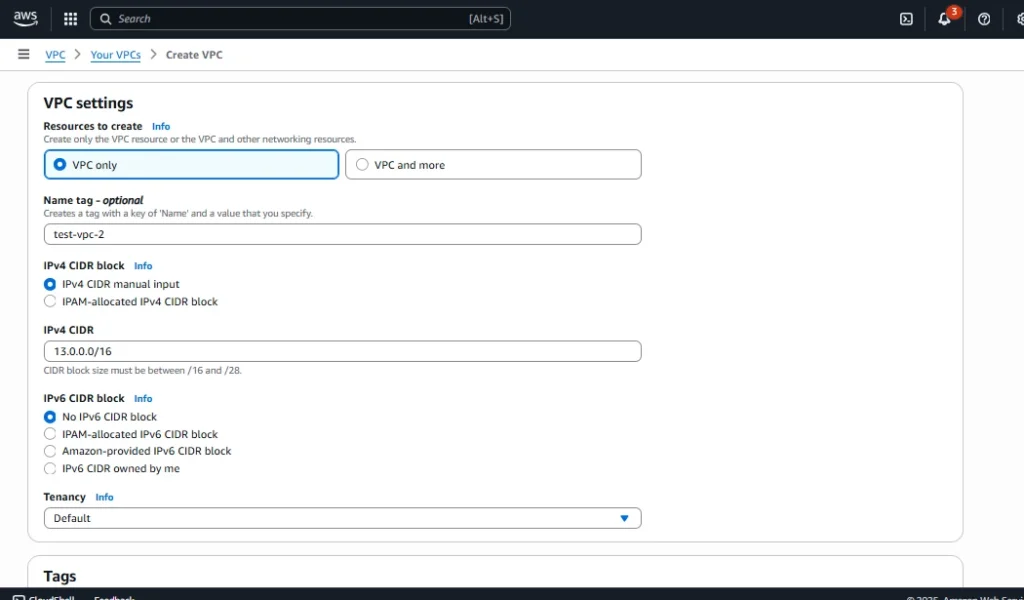
Step 3: Select “Peering Connections”
- Navigate to VPC Peering, and click on create VPC peering button.
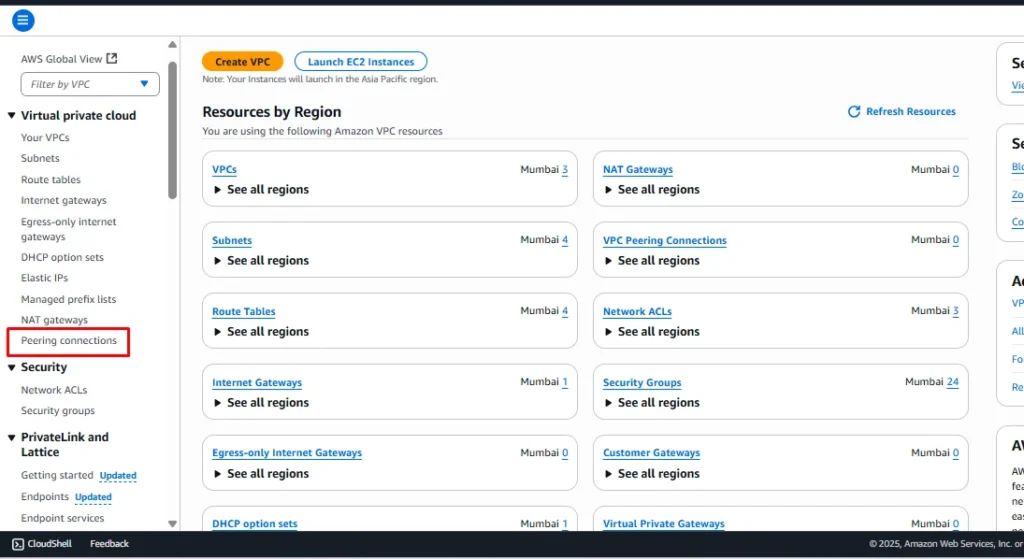
- Provide the accepter VPC name and receiver VPC name.
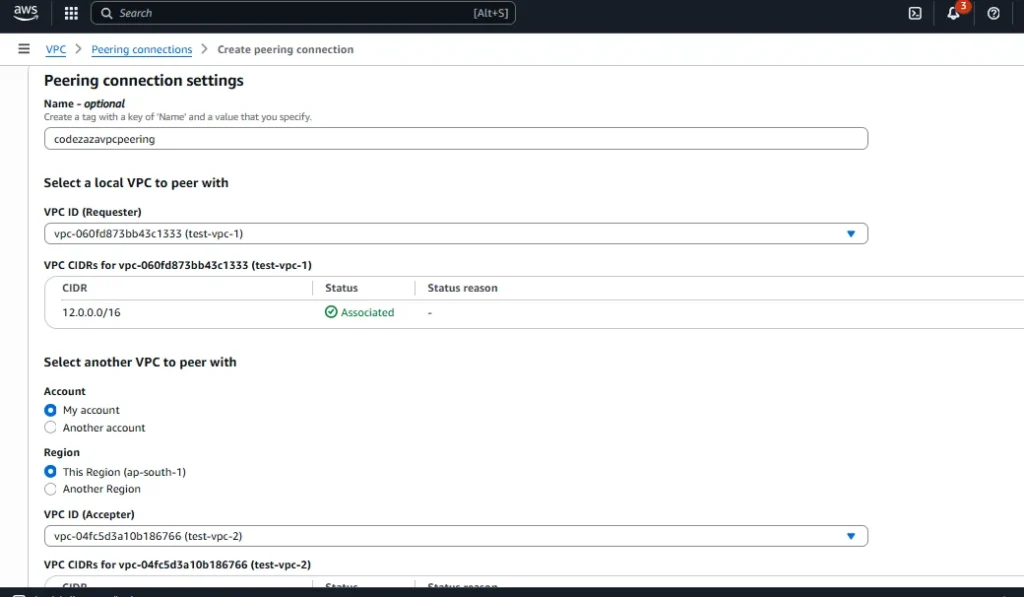
Step 3: Click “Create Peering Connection”
- After creating the vpc peering connection, it will be in pending status .

Step 4: Accept Peering Connection
- Now, from the myvpc2 aws account, go to vpc peering dashboard, click on the accept request and accept the peering connection.
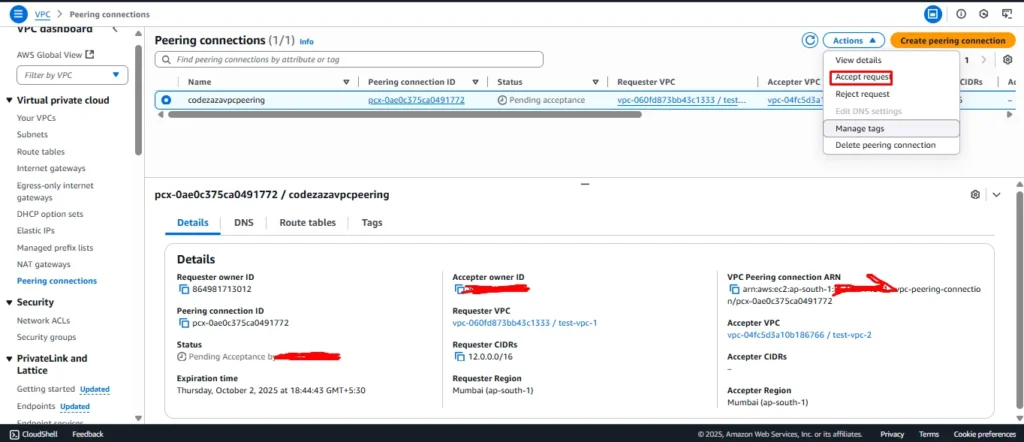
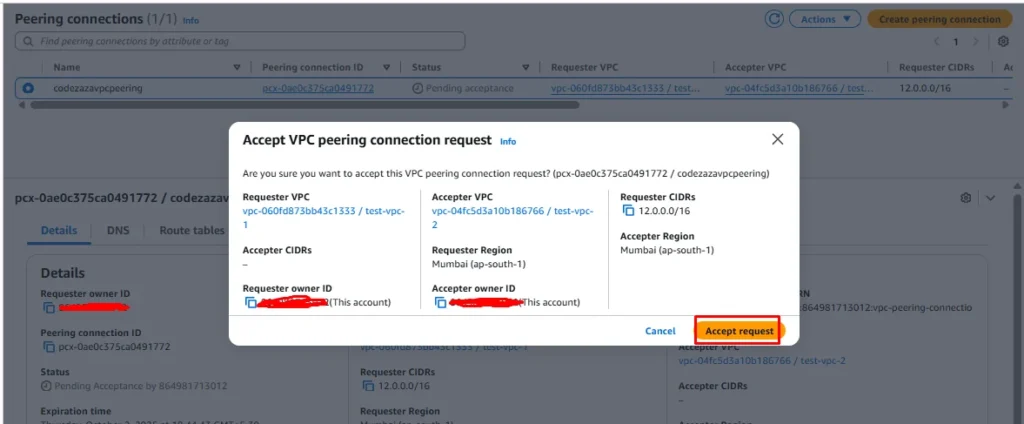
Step 5: Successful VPC Peering Connection
- After once the myvpc2 network accepts the request, the VPC peering connection will become active in status.

Step 6: Update Route Tables (if necessary)
- Ensure that the route tables for both VPCs are updated to include routes for each other’s CIDR blocks, pointing to the peering connection.


Step 7: Verify Connectivity
- Now, Create an instance on each vpc and try on pinging the private IP of instance on each other instance.
- If they are successfully pinging then you have established VPC peering successfully.

Sometimes we need to allow resources in different VPCs to exchange data based upon the architecture of the service. Regardless of any specific need, using VPC peering is a great way of extending your VPC design.
Note: When you start to have a lot of peering connections between multiple VPCs, in multiple regions, across multiple AWS accounts, managing the connections. When it starts to get difficult, it is time to start looking at moving the existing peering connections to Transit Gateway and managing the connections there.
AWS VPC Peering Latency
AWS VPC Peering generally offers low level latency communication between the peered VPCs that are in same region. The traffic flows over the network, latency is generally minimal making it suitable for real-time applications and services. The latency is generally depends on the factors such as geographical distances between VPCs and potential network congestion which can slightly affect latency. AWS VPC peering is designed for efficient and reliable connectivity with minimal latency for inter-VPC communication.
AWS VPC Peering Bandwith
AWS VPC Peering connections provide scalable, high-bandwidth communication between peered VPCs. The available bandwidth depends on the type of EC2 instances and their respective network performance capabilities. For example, instances optimized for high network throughput can handle larger amounts of traffic between VPCs.
To further enhance connectivity, organizations can use AWS Direct Connect or AWS VPN connections. These services increase the bandwidth between VPCs and on-premises networks, ensuring smooth data transfer for demanding workloads. By combining VPC peering with Direct Connect or VPN, businesses can achieve reliable, low-latency communication across hybrid environments.
AWS VPC Peering Cross Account
AWS VPC Peering Connection can be establishable across AWS Accounts known as cross-account VPC peering. This feature enables the organizations to establish secure and private ccommunication channels between VPCs that belonging to seperate AWS Accounts within same region. The cross account VPC peering requires explict acceptance from both the AWS Accounts, ensuring the adminstrators to maintain the control over the network access and security policies.
Advantages of VPC Peering
The following are the advantages of VPC peering:
- Seamless Communication: It helps in directing and securing the connection between the VPCs. It facilitates with this in sharing of resources and data transfers.
- Cost Efficiency: On establishing the private network communication based VPC peering removes the need of expensive public internet data transport making cost efficiency.
- Simplified Network Management: VPC peering simplifies the network architecture making it easier of network management and resolving complexities associated with traditional networking.
- Resource Access: VPC peering provides the access to the resources in different VPCs enhancing the efficiency of organizations services across interconnected networks
VPC Peering Limitations & Rules
VPC Peering mechanism used in cloud for connecting multiple VPCs within same or different regions on the network. Even though it is a powerful tool, It is also comes up with some limitations. The following are the limitations of VPC Peering:
- No Transitive Peering: One of the primary limitations of VPC peering is not supporting temporary peering. Each Peering connection must be established individually to provide communication i.e., If VPC A is peered with VPC B and VPC is peered with VPC , VPC A cannot communicated directly with VPC C through VPC peering connection between A and B.
- CIDR Block Overlapping: For Establishing VPC Peering we have to ensure to maintain non-overlapping CIDR blocks to the VPCs. If CIDR overlaps then peering connection is not possible to establish.
- Limited Support For Transitive Routing: Transitive routing is not crucial for native VPC peering even though several cloud providers have developed features providing limited support on using through transit gateways or shared services.
- Cross Region Limitations: Usually VPC peering is limited to the same cloud Area. You might need to look at alternate options including VPN connection or cloud provider’s inter-region peering services, if you need to link VPCs in various areas. This limitation can impact organizations with distributed or globally scattered infrastructure.
Pricing for a VPC Peering Connection
AWS charges for VPC Peering connections based on the type of usage and resources involved. The following table summarizes the typical pricing components:
| Component | Description | Cost |
|---|---|---|
| VPC Peering Connection | Used to establish a VPC Peering connection between two VPCs. | $0.01 per GB |
| Data Transfer between VPCs | Facilitates the transfer of data across peered VPCs. | $0.02 per GB |
| NAT Gateway | Applies if you route VPC traffic through a NAT Gateway. | Additional fee |
| Data Processing | Charges apply if your VPC performs processing tasks on transferred data. | Variable (depends on processing parameters) |
| Support | Optional AWS support for managing VPC Peering connections. | Variable (depends on support plan) |
Conclusion
In Conclusion, Amazon VPC peering is an Import networking features that is providing by AWS. It is an efficient and secure method to connect different virtual private clouds( VPCs). The concepts of VPC peering have been explained along with facilitating its importance. The implementation steps guide you as instructions for VPC peering. On knowing benefits, drawbacks and real world usecases from this article, we hope you can work your enterprises and improve your infrastructure performances.

